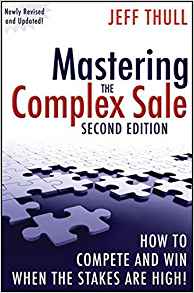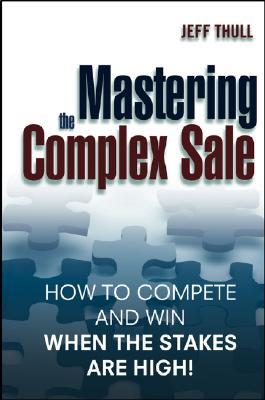Question – what book do you recommend for understanding complex B2B selling environments?
Answer – Mastering the Complex Sale
The author, Jeff Thull, is an interesting person. He looks like a seasoned college professor but he’s a great consultant and trainer!
Jeff is not full of hyperbole and arrogance. He writes from a practical, hands-on perspective that leads to specific actions. Jeff’s grasp of complex selling is brilliant. He also has a host of other books on sales and sales management. I cannot speak highly enough about Jeff and his approach to mastering complex selling environments!
With that said, Mastering the Complex Sale reaches a similar conclusion about selling in complex situations as other authors. They emphasize the need for salespeople to focus on the buyers purchasing process first before “pitching” their offerings.
The conclusion they reach is that salespeople must learn to ask more questions and listen more. I agree with this conclusion. In most cases, the solution they recommend is selling skill training. I do not fully agree with this conclusion. While both skills are important this is a minor challenge for most B2B salespeople.
That is why selling skill training tends to fail. Because it does not address the root cause problem that salespeople face in complex selling situations.
Here’s a simple exercise.
Ask your salespeople if they believe that it’s important to ask questions and listen to buyer’s answers about their situation and purchasing process. You might be surprised to find that eight out of ten salespeople respond with an emphatic YES! Therefore, it’s a safe bet that your salespeople know that they need to ask more questions and listen more.
So, while Mastering the Complex Sale is a great primer you might find that conducting selling skill training is a waste of time, money, and morale.
What is the primary challenge for complex sales conversations?
Salespeople struggle during complex selling situations to manage the exchange of information between themselves, the buyer, and internal experts. To successfully navigate the exchange of information, salespeople are required to review, memorize, remember, and verbally present:
- A sequence of questions and answers to help match the buyer’s needs with the seller’s solutions.
- An in-depth hierarchy of products, services, pricing models, and discount information.
- Instantly find and access support information live-time during sales conversations. Many salespeople end sales calls to gather answers to buyer’s questions. Some are even forced to contact technical experts to get answers. This adds to sales cycle time, increases buyer confusion, and decreases the probability of a sale.
- Keep up with changes to products, services, pricing models, and discounts. It’s common practice to publish changes in emails which forces salespeople to stop selling and spend time reading. Some companies hold webinars or meetings to train salespeople on these changes.
Both kill sales productivity and frustrate salespeople. To further complicate things, It’s common to hear business leaders complain that salespeople spend too much time reading email. Then in the next breath, they complain that salespeople are not presenting the company’s latest offerings and messaging. How are salespeople supposed to present information that they do not know?
Unfortunately, Mastering the Complex Sale does not address this root cause problem.
So, here’s the million-dollar question.
How do you transfer information to salespeople without wasting time, money, and morale?
I’ve found that using a visual knowledge transfer tool solves this problem. This type of tool is used when:
- Managing sales conversations. To get and keep the buyer and seller visually on the same page across all stages of the sales conversation. It also provides instant, real-time access to support information and answers to buyer’s questions.
- Onboarding new salespeople. To nearly eliminate the time needed for salespeople to review, memorize, and remember sales information.
- Communicating updates to salespeople. To eliminate time spent reading, memorizing and remembering emails and attending training meetings.
- Launching new products and services. To eliminate time that product managers spend writing email briefings, as well as building and delivering training meetings for salespeople. It also eliminates wasted time for salespeople i.e. reading emails and attending training.
- Coaching salespeople. To enable consistency from sales conversation-to-conversation and sales person-to-person.
Recommendations
In short, I have two recommendations:
- Read Mastering the Complex Sale. It’s a great primer for new salespeople on how to manage B2B sales conversations.
- Define the problem that your salespeople face in complex selling situations as a knowledge transfer problem – – not a selling skill training problem. This will open your thinking about how to solve the problem without wasting time, money, and morale on selling skill training.
Check out TheNaviGuide™ visual knowledge transfer tool and methodology.
So Please Take A Minute To:
- Write a comment on this post
- Share this blog with other sales leaders, salespeople, CEO’s and investors
Click Here to learn more about Chief Sales Leader™



